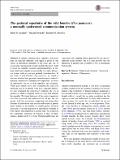The gestural repertoire of the wild bonobo (Pan paniscus) : a mutually understood communication system
Abstract
In animal communication, signallers and recipients are typically different: each signal is given by one subset of individuals (members of the same age, sex, or social rank) and directed towards another. However, there is scope for signaller-recipient interchangeability in systems where most signals are potentially relevant for all age-sex groups, such as great ape gestural communication. In this study of wild bonobos (Pan paniscus), we aimed to discover whether their gestural communication is indeed a mutually understood communicative repertoire, in which all individuals can act as both signallers and recipients. While past studies have only examined the expressed repertoire, the set of gesture types that a signaller deploys, we also examined the understood repertoire, the set of gestures to which a recipient reacts in a way that satisfies the signaller. We found that most of the gestural repertoire was both expressed and understood by all age and sex groups, with few exceptions, suggesting that during their lifetimes all individuals may use and understand all gesture types. Indeed, as the number of overall gesture instances increased, so did the proportion of individuals estimated to both express and understand a gesture type. We compared the community repertoire of bonobos to that of chimpanzees, finding an 88% overlap. Observed differences are consistent with sampling effects generated by the species’ different social systems, and it is thus possible that the repertoire of gesture types available to Pan is determined biologically.
Citation
Graham , K E , Furuichi , T & Byrne , R W 2017 , ' The gestural repertoire of the wild bonobo ( Pan paniscus ) : a mutually understood communication system ' , Animal Cognition , vol. 20 , no. 2 , pp. 171-177 . https://doi.org/10.1007/s10071-016-1035-9
Publication
Animal Cognition
Status
Peer reviewed
ISSN
1435-9448Type
Journal article
Description
Funding was provided by the Wenner-Gren Foundation Dissertation Fieldwork Grant, Japan Society for the Promotion of Science (JSPS) Grant in Aid for Scientific Research, JSPS Core-to-Core Program, and University of St Andrews 600th Anniversary Scholarship.Collections
Items in the St Andrews Research Repository are protected by copyright, with all rights reserved, unless otherwise indicated.

